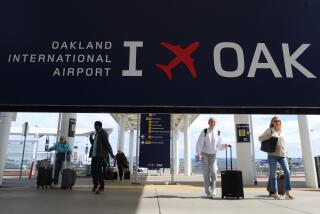S.F. Airport Wants United to Cut Flights
- Share via
Among the many things San Francisco is known for are tardy takeoffs and landings at the city’s airport. A third of them don’t leave or arrive when they’re supposed to, infuriating everyone from business travelers to Mayor Willie Brown.
The airport is considering various remedies, including one that officials don’t believe any other city has ever tried.
They intend to ask the Federal Aviation Administration for authority to tell United Airlines, the airport’s leading carrier, to cut the number of its California flights.
The plan, which has United sputtering, is intended to relieve airport congestion by making the airline use fewer, larger planes on some state runs, including its popular Los Angeles shuttle and feeder routes from smaller cities.
“This is a landmark kind of issue. It has implications way beyond San Francisco Airport,” said Denis Horn, general manager of the Monterey Peninsula Airport District, which will lose some service to San Francisco if the proposal goes through.
The fifth-busiest airport in the nation, San Francisco handles 1,260 flights a day, many of them operated by United. Every time the Northern California fog rolls in or clouds are low, arrivals and departures are held up because the runways are too close together to allow more than one aircraft on them during periods of low visibility.
Airport officials say the ultimate answer is an expensive and controversial plan to expand the runways by filling in as much as 1,300 acres of San Francisco Bay.
In the meantime, they are looking at temporary fixes, among them the flight reductions and installation of a more sophisticated radar system.
“We think the proposal is seriously misguided,” complained United spokesman Matthew Triaca. “It is attempting to tell United Airlines how best to run our business. . . . We think this action is unprecedented.”
San Francisco International Airport spokesman Ron Wilson said officials intend to petition the FAA this week for authority to make United change its scheduling. It wants the airline to drop its 30-passenger, propeller-plane runs to smaller California cities such as Sacramento and Monterey and replace them with larger aircraft flying less often.
The airport similarly wants United to cut a portion of its jet shuttle flights on the busy San Francisco-to-Los Angeles route, replacing them with bigger planes departing less frequently.
The reaction among smaller cities has been mixed. Laura Gipson, operations manager for Sacramento International Airport, said passengers want a broad choice of flight times.
“People would prefer to go when they want to go,” she observed. The San Francisco proposal would cut United’s daily Sacramento flights to San Francisco from 16 to 10.
In Monterey, Horn said the majority of passengers would probably not mind, as long as jet flights took the place of props.
Triaca said that United’s schedule is based on demand and that dropping flights would hurt business.
He added that the company in the past year has reduced its daily flights by about 12% in San Francisco and has taken steps to shorten the turn-around time on its shuttle route.
“The issue at SFO isn’t congestion,” he said. “It’s an antiquated runway configuration.”
But the $2.5-billion runway expansion hasn’t been approved yet, and wouldn’t be completed for another seven years or so.
The project has encountered environmental opposition because it would require so much filling of the bay, affecting wildlife habitat and water circulation.
Airport officials say they would offset the environmental damage by paying for the restoration of as much as 20,000 acres of wetlands along the southern side of the bay.
Hemmed in between U.S. 101 and the bay, the airport’s parallel runways are separated by only 750 feet.
The expansion would put 4,300 feet between the runways, allowing simultaneous landings at any time.
More to Read
Sign up for Essential California
The most important California stories and recommendations in your inbox every morning.
You may occasionally receive promotional content from the Los Angeles Times.











